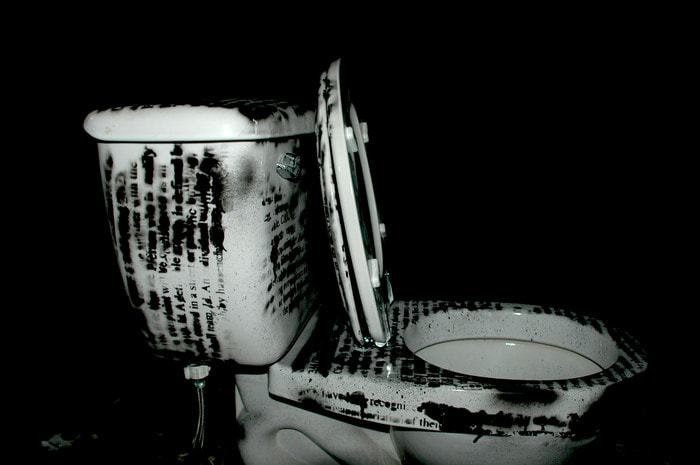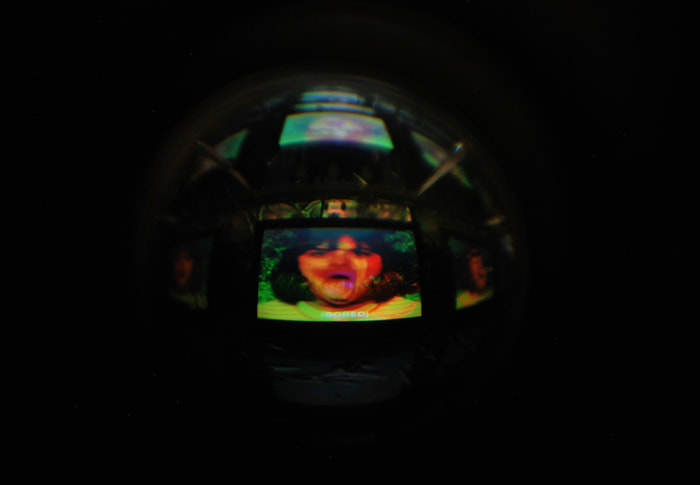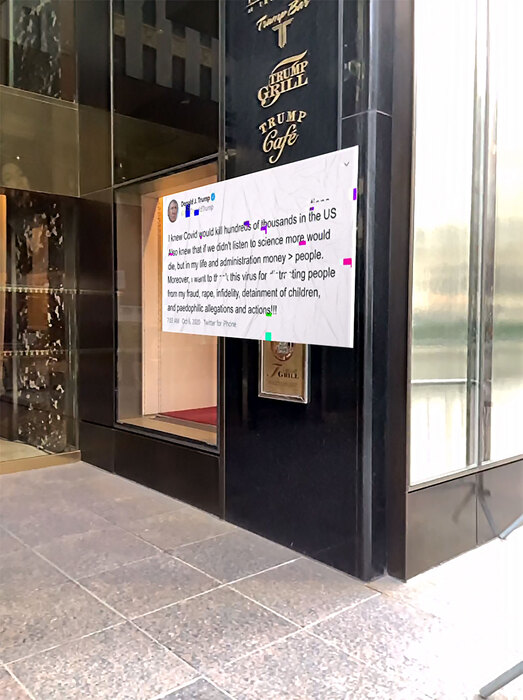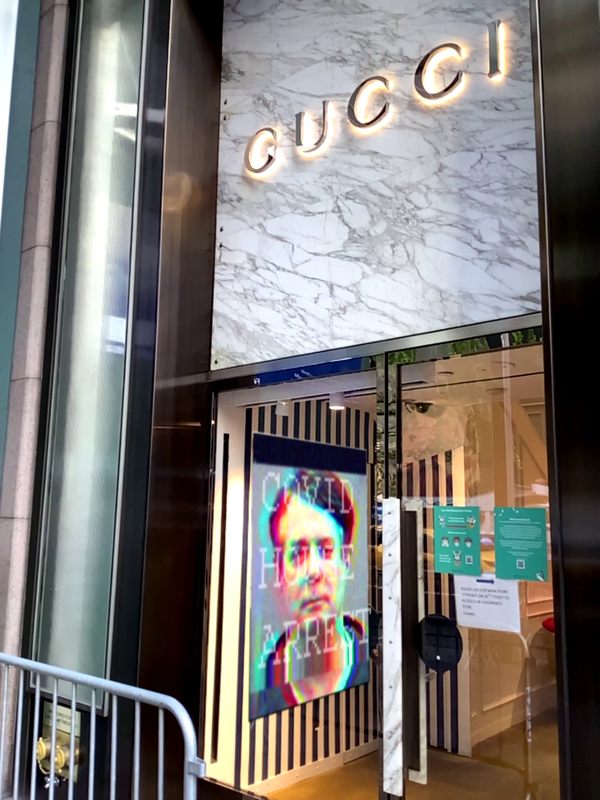June 2022
INVITATIONAL EXHIBITION
Brian McSherry
Artist Statement
Brian McSherry, a designer from New York, strays from the path of the expected by approaching his work with a sense of experimentation, theory, and law. He pushes the limits of what design is considered in the social and legal realms and is constantly creating his own definitions. As a trained artist and lawyer he creates work that challenges the law both visually and vocally.
Previously, McSherry has focused on aspects of law that touch upon celebrity identity, right of publicity, and copyright infringement with illegal or non-fixed materials and practices as investigation towards legal legibility.
Currently, McSherry is investigating if art, design, and law can legally affect politics and
social equity in the United States, specifically when it comes to symbols of hate. This proposal of future work looks towards a specific intersection of art, design, physical property, and legal loopholes to answer the aforementioned question raised by this investigation as it relates to proposed border policies in the United States, gentrification, and hostile design within privately owned public spaces (POPs). At the intersection of art and law in the United States is the Visual Artists Rights Act (VARA) of 1990, which forbids the destruction or manipulation of copyrightable works of art.
Recently, the destruction of 5pointz, a derelict graffiti haven in Long Island City,
exemplified the power that VARA has as it relates to real estate production. Jerry Wolkoff, the owner and developer of 5pointz, was forced to pay 45 graffiti artists a total of $6.7million in restitution for the destruction of the artists’ work. However, can VARA be used as an estoppel to the destruction of art, or is it merely a remedy for damages? According to the case of David Phillips, VARA allows for a temporary restraining order to protect works that are likely to be altered.
This proposal of future works looks at these cases, the history of VARA, temporary
restraining orders as a guide to create site-specific graphical work to stop symbols of hate. For example, in order to halt the production of a border wall, one must purchase a parcel of land and create a site-specific graphical structure. Here, one will not only have real estate protection but also protection in the intellectual property of the work and the protection under VARA. Thus, an artist can use law as art and art as law to create a visual and physical safe haven in an area brimming with symbols of hate and exclusion.
However, what about spaces not owned by the artist? Will VARA still apply for spaces
that invite the public to congregate within a private space, such as a POPs location? While this tends to extend into the realm of public art and graffiti it is the legal morality of graffiti that questions the artists protections from criminal and civil liability. This further begs the question, is there a form of graffiti that is legal in a case such as this, perhaps augmented reality graffiti?
All of these questions have yet to be answered by the courts or the legislative branch.
Moreover, these questions have not been answered even in an international context. It is my hope that this future works proposal of scholarly research can address these questions by influencing artists in multiple countries that work in the fringe in order to answer the legal questions that have yet to surface.
INVITATIONAL EXHIBITION
Brian McSherry
Artist Statement
Brian McSherry, a designer from New York, strays from the path of the expected by approaching his work with a sense of experimentation, theory, and law. He pushes the limits of what design is considered in the social and legal realms and is constantly creating his own definitions. As a trained artist and lawyer he creates work that challenges the law both visually and vocally.
Previously, McSherry has focused on aspects of law that touch upon celebrity identity, right of publicity, and copyright infringement with illegal or non-fixed materials and practices as investigation towards legal legibility.
Currently, McSherry is investigating if art, design, and law can legally affect politics and
social equity in the United States, specifically when it comes to symbols of hate. This proposal of future work looks towards a specific intersection of art, design, physical property, and legal loopholes to answer the aforementioned question raised by this investigation as it relates to proposed border policies in the United States, gentrification, and hostile design within privately owned public spaces (POPs). At the intersection of art and law in the United States is the Visual Artists Rights Act (VARA) of 1990, which forbids the destruction or manipulation of copyrightable works of art.
Recently, the destruction of 5pointz, a derelict graffiti haven in Long Island City,
exemplified the power that VARA has as it relates to real estate production. Jerry Wolkoff, the owner and developer of 5pointz, was forced to pay 45 graffiti artists a total of $6.7million in restitution for the destruction of the artists’ work. However, can VARA be used as an estoppel to the destruction of art, or is it merely a remedy for damages? According to the case of David Phillips, VARA allows for a temporary restraining order to protect works that are likely to be altered.
This proposal of future works looks at these cases, the history of VARA, temporary
restraining orders as a guide to create site-specific graphical work to stop symbols of hate. For example, in order to halt the production of a border wall, one must purchase a parcel of land and create a site-specific graphical structure. Here, one will not only have real estate protection but also protection in the intellectual property of the work and the protection under VARA. Thus, an artist can use law as art and art as law to create a visual and physical safe haven in an area brimming with symbols of hate and exclusion.
However, what about spaces not owned by the artist? Will VARA still apply for spaces
that invite the public to congregate within a private space, such as a POPs location? While this tends to extend into the realm of public art and graffiti it is the legal morality of graffiti that questions the artists protections from criminal and civil liability. This further begs the question, is there a form of graffiti that is legal in a case such as this, perhaps augmented reality graffiti?
All of these questions have yet to be answered by the courts or the legislative branch.
Moreover, these questions have not been answered even in an international context. It is my hope that this future works proposal of scholarly research can address these questions by influencing artists in multiple countries that work in the fringe in order to answer the legal questions that have yet to surface.

Brian McSherry received his Juris Doctor and Master of Fine Arts from SUNY Buffalo School
of Law and the University at Buffalo Graduate School in 2016. Currently, he is an Assistant
Professor of Graphic Design and Multimedia Production at Georgian Court University. His
scholarship focuses on national and international case law relating to visual design and innovative ways to use design for social change through the justice system. Recently, his work touching on areas of graphic design, augmented reality, copyright, celebrity, and the law has been exhibited by Ethan Cohen Gallery, Brooklyn Waterfront Artists Coalition, and Greenpoint Gallery.
His teaching and research interests span from traditional print and web design to
interactive installations for user interactions and experiences. Outside of the classroom, he has lectured both nationally and internationally at Groundswell Community Murals, University of Western Australia School of Law, DesignInquiry at Quinnipiac University, and the Design History Society’s Annual Conference in the United Kingdom. He has been awarded a Fulbright Fellowship to study design and the law at Concordia University in Montreal, QC and has been a Fellow at the Art & Law Program held at the Cornell Architecture Art Center Headquarters in New York, NY.
of Law and the University at Buffalo Graduate School in 2016. Currently, he is an Assistant
Professor of Graphic Design and Multimedia Production at Georgian Court University. His
scholarship focuses on national and international case law relating to visual design and innovative ways to use design for social change through the justice system. Recently, his work touching on areas of graphic design, augmented reality, copyright, celebrity, and the law has been exhibited by Ethan Cohen Gallery, Brooklyn Waterfront Artists Coalition, and Greenpoint Gallery.
His teaching and research interests span from traditional print and web design to
interactive installations for user interactions and experiences. Outside of the classroom, he has lectured both nationally and internationally at Groundswell Community Murals, University of Western Australia School of Law, DesignInquiry at Quinnipiac University, and the Design History Society’s Annual Conference in the United Kingdom. He has been awarded a Fulbright Fellowship to study design and the law at Concordia University in Montreal, QC and has been a Fellow at the Art & Law Program held at the Cornell Architecture Art Center Headquarters in New York, NY.
For inquiries contact the artist directly:
Brian McSherry
www.brianmcsherry.com
Phone: 845-551-2811
Email: [email protected]
Brian McSherry
www.brianmcsherry.com
Phone: 845-551-2811
Email: [email protected]








